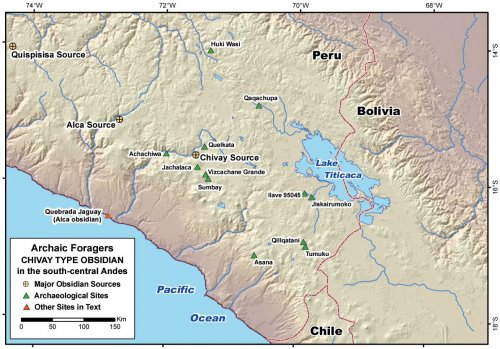3.5.1.Archaic Foragers in the South-Central Andes
To date, relatively few Archaic archaeological sites have been excavated in the area of the south-central Andean highlands, and therefore the regional knowledge of this important time period is limited. A brief overview of each period will be provided here, with an emphasis on archaeological sites containing Chivay type obsidian, in order to contextualize the regional relationships and interactions that were occurring during these preceramic periods. This review will focus on the western slope of the Andes and the Lake Titicaca Basin, the region where Chivay type obsidian abounds. Much of the Archaic Foragers obsidian in the literature that has been sourced was derived from undated, surface contexts from sites that are assumed to date to the Archaic based on projectile point styles or other inference by archaeologists. Klink and Aldenderfer's (2005) projectile point typology permits the classification of site occupations by time period with greater certainty during the Archaic when projectile point styles change with regularity. In some cases, the projectile point typology can be used to assign a date range to temporally diagnostic obsidian projectile points that have been directly analyzed for chemical provenience.
In Burger et al.'s (2000: 275-288) review, procurement and exchange during the preceramic is evaluated through chemical provenancing data from 87 obsidian samples, 70 of which are from the Chivay source. Unfortunately, of the thirteen sites where the samples were collected in the south-central highlands, only three sites (Chamaqta, Asana, and Sumbay) contain excavated contexts placing the samples in preceramic levels. The other samples are assigned to the preceramic group through inference from projectile points, or because they are from a-ceramic sites. The difficulty in this arises from the fact that obsidian was used with much greater frequency in the beginning of the pastoralist periods, as was mentioned above in the case of the Ilave valley (Section 3.4.4 ).
Obsidian materials from both the Chivay and Alca sources were transported relatively long distances from the Early Archaic onward, indicating that material from these obsidian sources has properties that were prized at a relatively early date. Sites such as Asana and Qillqatani, both over 200 linear km from the Chivay source, contain non-local obsidian through much of the preceramic sequence despite the immediate availability of high quality cherts, as well as the lower-quality Aconcahua obsidian, in the local area. This evidence underscores the nature of obsidian provisioning in the Archaic Period. As compared with later pastoralist use of obsidian, Archaic foragers were relatively selective in their use of raw materials. This may reflect the priority placed on dependable hunting technology as compared with the shearing and butchering needs of pastoralists, or the different social and symbolic priorities attached to obsidian by hunters versus herders.
Figure 3-11. Chivay type obsidian distributions during the "Archaic Foragers" time(circa 10,000 - 3,300 BCE).

